On the morning of December 6th, 1959, Dr. Harold Perelson walked into the master bedroom where his wife, Lilian, slept and bashed in her skull with a ball-peen hammer. The deed done, he padded down the hall, locked himself in the bathroom, and took his own life with a lethal cocktail of acid and tranquilizers.
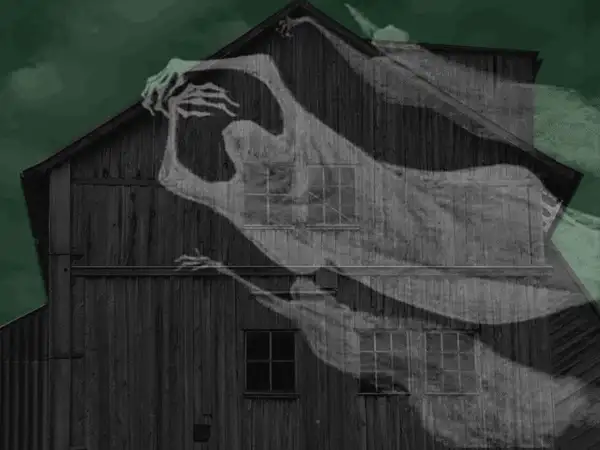
In the decades following this tragedy, the property, dubbed the “Los Feliz Murder Mansion,” fell into a state of uninhabited disrepair. Then, in 2016, a serial entrepreneur and tech investor named Braden Pollock purchased it for a steal at a probate auction.
Following the sale, Pollock made big plans to renovate the house and move into the master bedroom — the very same room where Lilian was brutally murdered 60 years earlier. He had no qualms about the house’s checkered past; he just wanted a screamin’ deal on a fixer-upper.
Homes where a high-profile crime or murder occurred can sell for as much as 10-25% under market rate — an enticing invitation for intrepid bargain hunters. But why exactly are these properties cheaper? And are the deals too good to be true?
It’s not haunted, it’s ‘stigmatized’
Randall Bell is a surprisingly upbeat guy given his morbid line of work.
In his 30+ years as a damaged real estate appraiser, he’s priced dozens of high-profile murder abodes — from the home where Nicole Brown Simpson was killed to the Heaven’s Gate house, where 39 cult members committed suicide in 1997.
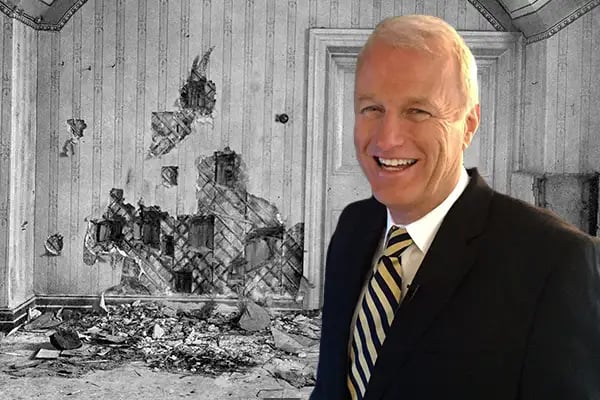
As the director of Landmark Research Group, Bell specializes in what the pros call “stigmatized properties,” or properties that buyers often shun for a number of non-physical reasons. The list of these stigmatizing events extends far beyond murder, and includes:
- Houses where cult activity took place
- Houses where famous adulteries took place
- Houses where illegal or illicit activity took place (e.g. meth labs)
- Houses with notorious ex-owners (sex offenders, mobsters)
- Houses near the site of a chemical or natural disaster
- Houses where a child was abducted or kidnapped
But murder houses seem to be in a category of their own.
Sometimes, murders that occur in a home leave collateral physical damage. In the Heaven’s Gate case, for instance, decomposing bodies left a horrific smell (and, adds Bell, “blood throughout the house”). But far more often, it’s the “reputational damage” that has a lasting impact on the salability of the home — not questionable carpet stains.
Depending on the notoriety of the events and the turnover of families in the area, this stigma can linger for generations: 60 years on from the crime, Pollock’s home is listed on Google maps as “The Los Feliz Murder House.”
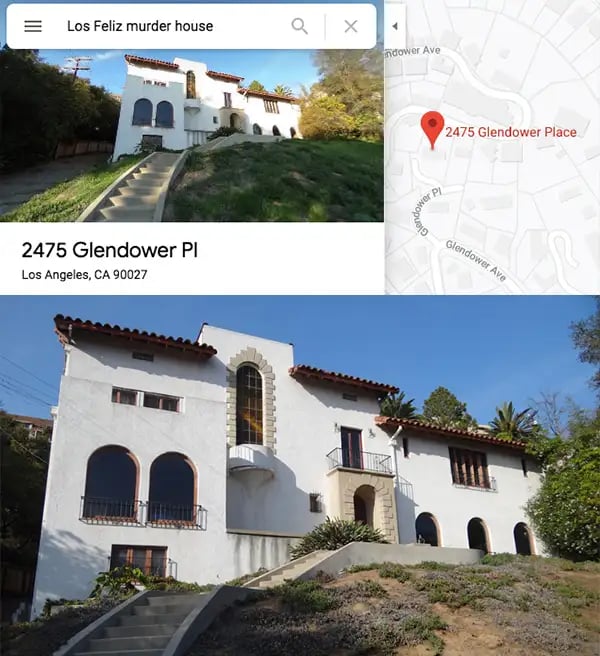
The mere presence of serial killer Jeffrey Dahmer’s Milwaukee apartment building depressed the value of surrounding homes for years, until a community development group bought it at a premium just to demolish it.
Sometimes, even a teardown doesn’t put a home’s past to rest: The ex-home of the Sandy Hook shooter, a 3,100-square-foot estate on a tree-lined street in Newtown, Connecticut, caused so much grief for local residents that it was torn down. But even after the land was donated to the town, the site retained haunting memories.
“People say real estate is all about location, location, location,” says Bell. “In reality, it’s perception, perception, perception.”
And as it turns out, this perception can have a massive impact on the value of a home.
The price of a bad reputation
According to Bell, a death in a home can decrease its value by 25%, and increase time spent on the market by 50%.
Pollock was able to nab the Los Feliz Murder Mansion — a 5-bedroom, Spanish-revival style estate with unobstructed hilltop views of downtown LA — for $2.3m, one-third of the cost of nearby properties. (It helps that’s he not superstitious: “If I were a ghost, I’d be hanging out in Bali, not rattling chains in my own attic,” he tells me.)
Similarly, the “Amityville Horror House,” where Ronald DeFeo killed an entire family in 1974, sold for a $250k loss in 2017. On Realtor.com, it’s listed as a “Stately Center Hall Colonial On Amityville River” in “mint condition.”
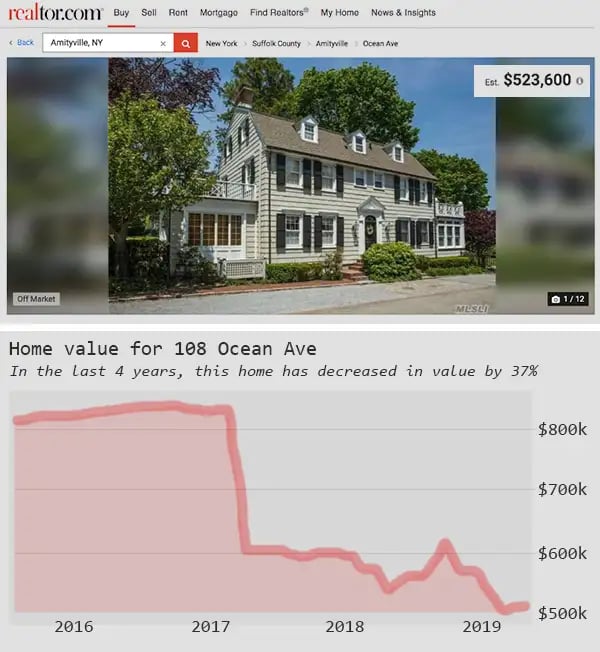
How exactly do bad vibes affect resale price? Bell says you can appraise any property based on three criteria: Cost, use, and risk:
- Cost = Price of sale + any foreseeable renovations or repairs
- Use = Potential income you could generate from the property
- Risk = Anything that could jeopardize the future value of the home
At the end of the day, ghosts are a risk. Because whether or not the buyer believes in them, they can still affect the public perception of a home — and create some very real logistical challenges for the people who live there.
Bell recalls two unhappy parents who contacted him after buying a home where a son shot and killed his parents. Both were science-minded PhDs who had no qualms with the home’s history, but were dismayed when their children were ostracized by the local kids who were scared of the property.
Then, there’s the realtor who brokered the past three sales of the Amityville home, who blames the onslaught of curious out-of-towners who stop and take pictures of the house for its steep depreciation — not buyer superstition.
And Pollock? Since purchasing the Los Feliz estate, he’s had so much trouble with break-ins by urban explorers and people trying to hold occult rituals that he put up a barbed wire fence around the property.
But where realtors and buyers see a headache, another man saw a business opportunity.
The niche business of murder homes
Back in 2013, software developer and part-time landlord Roy Condrey got a text from a tenant in the middle of the night: One of his rental properties, the tenant claimed, was haunted.
When he looked into the matter, Condrey discovered that the property’s previous owner had, in fact, died in the home. Moreover, he found that in many states, real estate agents aren’t legally required to disclose a death or any other event that doesn’t impact the physical structure of the property.
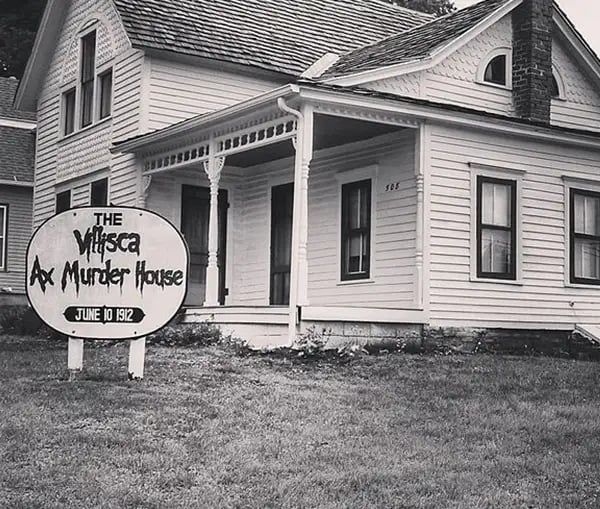
The legal precedent for real estate sales is essentially caveat emptor, or “buyer beware.” And, though the seller is technically supposed to tell you if you directly ask about a death in the home, it’s pretty difficult for a buyer to prove that the seller knowingly withheld information about a death.
Sensing a market opportunity, Condrey launched Diedinhouse.com, a site which, for $11.99 per search, scrapes over 118 million private and public records to tell you if (and even how) someone died in your home.
Without any marketing or paid advertising, Diedinhouse.com now gets thousands of organic hits a day via popular queries like “how to know if someone died in your house.” The site’s business model relies on a mixture of morbid curiosity and practical inquisitiveness.
“People talk a big game,” says Condrey, in his warm Carolina twang, “but when push comes to shove, they’re not going to buy a house where someone has been murdered.”
To test this statement, we asked 3,700 readers of The Hustle (a markedly entrepreneurial ilk) if they would buy a house that is rumored to be haunted. Nearly 4 in 10 respondents said they wouldn’t even consider it, even at a 25% markdown.
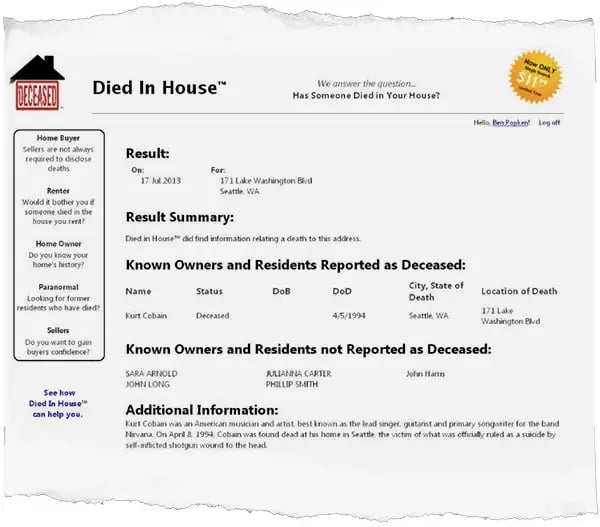
A possible explanation for this resistance is cognitive bias, or, more specifically, something called availability heuristic: A house where a brutal murder has been committed is a reminder that something terrible has happened in a neighborhood, and that makes it seem more likely to happen in the future.
Tips for supernatural deal hunters
For those who couldn’t care less about a decades-old double-homicide in their living room, there are certainly deals for the taking — so long as you follow a few rules of thumb for protecting the future value of your stigmatized property:
- Change the home’s address
- Alter the home’s appearance
- Wait 20 to 25 years, and hope that people move on
The first thing you’ll want to do is change the street address so tourists can’t find it. As a contingency plan, the outside appearance of the home should also be altered so people don’t associate it with the tragedy. Finally, give it time: Bell says that stigmatized home prices typically rebound after around 20 to 25 years.
For all the buyer horror stories you hear, stigmatized properties can be tremendous deals: The 6th Floor Texas School Book Depository from which Lee Harvey Oswald assassinated JFK sold for a measly $300K and was later turned into a multi-million-dollar museum.
The Los Feliz Mansion hasn’t been so lucky: City officials are now mandating Pollock to completely tear down the house and regrade the hill to comply with new property regulations.
Haunted? Maybe not. Either way, it was cursed from the start.
